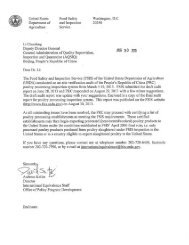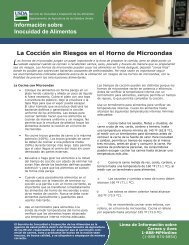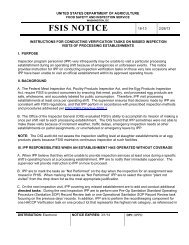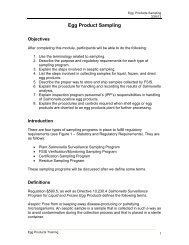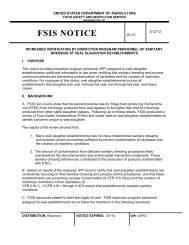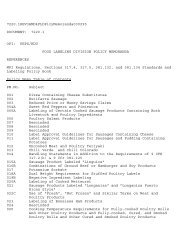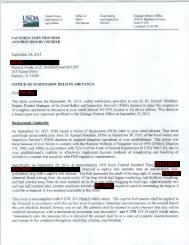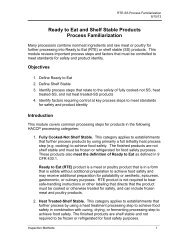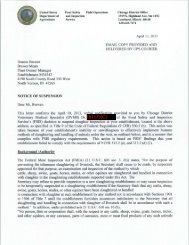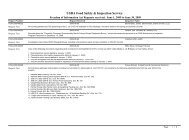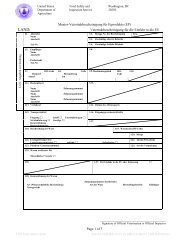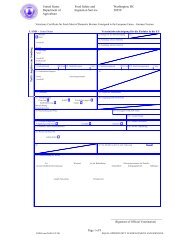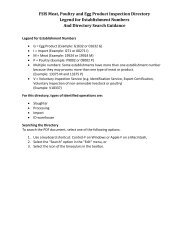Salmonella Action Plan - Food Safety and Inspection Service
Salmonella Action Plan - Food Safety and Inspection Service
Salmonella Action Plan - Food Safety and Inspection Service
Create successful ePaper yourself
Turn your PDF publications into a flip-book with our unique Google optimized e-Paper software.
December 4, 2013<br />
STRATEGIC PERFORMANCE WORKING GROUP<br />
SALMONELLA ACTION PLAN<br />
The <strong>Food</strong> <strong>Safety</strong> <strong>and</strong> <strong>Inspection</strong> <strong>Service</strong> (FSIS) has an increasing amount of performance information <strong>and</strong> data available.<br />
Recurring critical reviews of the information <strong>and</strong> data will allow the agency to identify deficiencies <strong>and</strong> successes that<br />
warrant particular attention. The FSIS Administrator established the Strategic Performance Working Group (SPWG) to<br />
perform such critical performance reviews <strong>and</strong> to solicit <strong>and</strong> coordinate ideas within the Agency on how to improve<br />
agency performance.<br />
The SPWG focused its first series of activities on identifying potential interventions or actions to decrease FSISattributable<br />
Salmonellosis. It decided on that focus because: 1) <strong>Salmonella</strong> is the pathogen that contributes the most to<br />
the FSIS’s ‘All-Illness’ performance measure; <strong>and</strong> 2) since the All Illness Measure was created, <strong>Salmonella</strong> illness<br />
estimates have continued at a steady high or slightly increased rate despite FSIS interventions.<br />
To gather ideas about actions FSIS could take to decrease Salmonellosis, the SPWG hosted a series of agency<br />
teleconferences <strong>and</strong> an interactive blog with participation by FSIS personnel throughout the agency. On the basis of the<br />
ideas <strong>and</strong> input received via those teleconferences <strong>and</strong> the blog, the SPWG developed this priority list of actions the<br />
agency plans to undertake. 1<br />
1. Proposed Poultry Slaughter Rule<br />
Although not a part of the work of the SPWG, FSIS has proposed a modernization of poultry slaughter<br />
inspection. This proposal is very important with respect to the Agency’s efforts on <strong>Salmonella</strong> because<br />
FSIS estimates that the modernization in inspection activities is likely to result in a reduction of at least<br />
4,286 <strong>Salmonella</strong> illnesses per year in the United States (Q3 FY2014).<br />
2. Sampling Related Activities<br />
To ensure that FSIS’ sampling is in line with current <strong>and</strong> emerging trends in foodborne illness, FSIS will<br />
undertake the following actions, which are consistent with the agency’s data-driven approach to<br />
preventing illnesses outlined in <strong>Food</strong> <strong>Safety</strong> <strong>and</strong> <strong>Inspection</strong> <strong>Service</strong>’s Annual Sampling Program <strong>Plan</strong><br />
Microbiological <strong>and</strong> Residue Sampling Programs Fiscal Year 2014:<br />
• test comminuted poultry in order to generate data for a new performance st<strong>and</strong>ard (ongoing);<br />
• continue to investigate whether there are products currently not subject to sampling that should be<br />
<strong>and</strong> that, therefore, are not being evaluated according to the performance st<strong>and</strong>ards (> 1 year); <strong>and</strong><br />
• explore developing a <strong>Salmonella</strong> sampling program for pork products (e.g., ground pork <strong>and</strong> other<br />
comminuted pork), including generating a performance st<strong>and</strong>ard (begin Q2 FY2014). 2<br />
3. Develop New In <strong>Plan</strong>t Strategies<br />
Providing inspection program personnel (IPP) with information about an establishment’s performance<br />
could help the IPP assess the establishment’s overall performance, point toward areas of concern <strong>and</strong><br />
provide the basis for enforcement action if necessary. Therefore, FSIS will:<br />
• develop a directive <strong>and</strong> training for inspection staff on how to assess developing in-plant conditions<br />
that may indicate a problem in adequately addressing <strong>Salmonella</strong> (> 1 year);<br />
1 In addition to the ideas gathered, to provide the overall breadth of the agency’s actions of decrease Salmonellosis, this<br />
<strong>Salmonella</strong> <strong>Action</strong> <strong>Plan</strong> includes items that FSIS had already committed to doing. The timeframe (short, medium or long term)<br />
for each action is included in parentheses.<br />
2 Outbreak data indicate that pork products contribute to <strong>Salmonella</strong> illnesses. FSIS stopped sampling pork carcasses because<br />
the percent of pork carcass samples positive for <strong>Salmonella</strong> was consistently very low. Pork products are not currently<br />
sampled for <strong>Salmonella</strong> testing.<br />
1
December 4, 2013<br />
• consider adding an establishment’s <strong>Salmonella</strong> category to the establishment profile in the Public<br />
Health Information System (PHIS) so IPP will have information about the overall performance of the<br />
facility <strong>and</strong> how to focus their actions (> 1 year);<br />
• consider whether to include a summary of an establishment’s performance on public health<br />
noncompliance records (NRs) in the establishment PHIS profile, <strong>and</strong> whether additional aspects of<br />
PHIS’ functionality (e.g., alerts) could help focus IPP activities (> 1 year);<br />
• initiate food safety assessments (FSAs) in comminuted poultry operations (Q4 FY2014);<br />
• complete the analysis of the 30 establishments where Hazard Analysis Verifications (HAVs) are<br />
currently implemented <strong>and</strong>, depending on the findings from those analyses, exp<strong>and</strong> the<br />
implementation of HAVs in poultry operations (Q2 FY2014).<br />
4. Develop a Directive for Sanitary Dressing in Hogs<br />
There is evidence from outbreak data that pork products contribute to <strong>Salmonella</strong> illnesses. Decreasing<br />
sanitary dressing problems in hog slaughter establishments, particularly related to removing the skin,<br />
could decrease a source of <strong>Salmonella</strong> on carcasses. FSIS does not currently have a directive for<br />
verification activities related to sanitary dressing in hog slaughter establishments. Therefore, FSIS will<br />
• publish a directive that provides instructions to FSIS inspection personnel on the verification activities<br />
related to sanitary dressing procedures in hog slaughter operations (Q4 FY2014).<br />
5. Consider Modifying How we Post <strong>Salmonella</strong> Categories<br />
Data indicate that posting the names of broiler <strong>and</strong> turkey establishments that are in Category 3 for<br />
<strong>Salmonella</strong> set results led to improved control of <strong>Salmonella</strong> in those establishments. FSIS ceased webposting<br />
of Category 2 establishments as of June 2011. Data collected by the Agency since then, however,<br />
do not show continuous improvement in industry performance, <strong>and</strong> FSIS believes that making more<br />
information about the process control performance of these establishments available will provide a<br />
valuable incentive for industry to improve process control. Therefore, FSIS will:<br />
• continue to collect data on the performance of establishments under the <strong>Salmonella</strong> performance<br />
st<strong>and</strong>ards for young chicken <strong>and</strong> turkey carcasses implemented in 2011 (ongoing);<br />
• continue to collect data on whether the current performance will produce the reduction in illnesses<br />
that the Agency predicted when it adopted the st<strong>and</strong>ards (ongoing); <strong>and</strong><br />
• depending on what it finds from the above two bullets, consider posting Category 2, <strong>and</strong> perhaps<br />
Category 1, establishments in addition to Category 3 establishments on its website; changes to<br />
posting would be announced in the Federal Register (Q4 FY2014).<br />
6. Other Performance St<strong>and</strong>ard Related Activities<br />
Healthy People 2020 Goals <strong>and</strong> FSIS’ strategic goals include a reduction in the illnesses attributable to<br />
FSIS-regulated products. Linking <strong>Salmonella</strong> performance st<strong>and</strong>ards to those goals <strong>and</strong> focusing activities<br />
on improving the performance of establishments relative to those st<strong>and</strong>ards could move the agency<br />
closer to those goals. To that end, FSIS will:<br />
• complete a risk assessment <strong>and</strong> develop st<strong>and</strong>ards for comminuted poultry products (Q4 FY2014);<br />
• complete a risk assessment <strong>and</strong> develop st<strong>and</strong>ards for poultry parts (Q4 FY2014);<br />
• develop st<strong>and</strong>ards <strong>and</strong>, if needed, sampling programs for hog carcasses <strong>and</strong> pork products (> 1 year);<br />
• develop performance st<strong>and</strong>ards that are linked to Healthy People 2020 Goals, that could incorporate<br />
the concept of the moving window 3 depending on public comments, <strong>and</strong> announce them in the<br />
Federal Register (begin Q4 FY2014); <strong>and</strong><br />
3 A “moving window” sampling plan is one in which FSIS would evaluate a set number of sequential results from a single<br />
establishment to assess process control. For example, if FSIS chose to evaluate 20 results under the moving window<br />
2
December 4, 2013<br />
• consider implementing new performance st<strong>and</strong>ards that could target FSIS testing in establishments<br />
with poor performance for sanitary dressing until two mini-sets show a level of control equal to a<br />
Category 1 establishment (> 1 year).<br />
7. Develop New Enforcement Strategies<br />
FSIS needs new enforcement strategies that take a systems or overall process control approach <strong>and</strong> link<br />
NR histories, <strong>Salmonella</strong> categories under the performance st<strong>and</strong>ards, <strong>and</strong> sanitary dressing findings.<br />
Therefore, FSIS is:<br />
• looking at enforcement <strong>and</strong> NR history, including looking at what establishments have been in<br />
Category 3 for many years without any enforcement actions, to determine if there is a way to link to<br />
sanitary dressing problems <strong>and</strong> <strong>Salmonella</strong> issues (> 1 year).<br />
8. Explore the Contribution of Lymph Nodes to <strong>Salmonella</strong> Contamination<br />
Some data, including research results from the Agricultural Research <strong>Service</strong> (ARS), indicate that lymph<br />
nodes could be a source of <strong>Salmonella</strong> contamination. In addition, data from the Agricultural Marketing<br />
<strong>Service</strong> (AMS) might help determine the effects of lymph nodes on contamination. Therefore, FSIS will:<br />
• identify, in coordination with ARS, the available research on lymph nodes (Q4 FY2014);<br />
• explore whether AMS data, combined with FSIS data, could provide information about the effects of<br />
lymph nodes on <strong>Salmonella</strong> contamination (Q4 FY2014); <strong>and</strong><br />
• reach out to work with industry to determine the extent of the problem of <strong>Salmonella</strong> from lymph<br />
nodes <strong>and</strong> to identify possible solutions (Q4 FY2014);<br />
• depending on the findings in the previous three bullets <strong>and</strong> announcing the sampling change in the<br />
Federal Register, begin collecting samples of beef <strong>and</strong> pork tissue containing specific lymph nodes<br />
from establishments where warranted (> 1 year).<br />
9. Pre-harvest Related Activities<br />
Pre-harvest contamination can affect the level of <strong>Salmonella</strong> on FSIS-regulated products. Synthesizing<br />
information on pre-harvest interventions from previous <strong>and</strong> on-going FSIS activities, <strong>and</strong> other<br />
information available from industry, could help decrease the prevalence or levels of <strong>Salmonella</strong> on FSISregulated<br />
products. Therefore, FSIS will:<br />
• develop a document summarizing the lessons learned from previous poultry <strong>and</strong> beef pre-harvest<br />
meetings 4 , <strong>and</strong> how those lessons were incorporated into or informed FSIS policies. The document<br />
should include a discussion of how FSIS has worked with the <strong>Food</strong> <strong>and</strong> Drug Administration (FDA) <strong>and</strong><br />
the Animal <strong>and</strong> <strong>Plan</strong>t Health <strong>Inspection</strong> <strong>Service</strong> (APHIS) to overcome regulatory barriers (Q3 FY2014);<br />
• continue to work with industry members on specific outbreaks to identify best practices they have<br />
developed for pre-harvest (ongoing); <strong>and</strong><br />
• after the above two bullets have been completed, organize <strong>and</strong> host a pre-harvest poultry meeting to<br />
focus on those issues. FSIS will then use the information gathered at that meeting to inform future<br />
policies or best-practice guidelines (> 1 year).<br />
10. Focus the Agency’s Education <strong>and</strong> Outreach Tools <strong>and</strong> Resources on <strong>Salmonella</strong><br />
New approaches or routes for providing <strong>Salmonella</strong>-related food safety messages to the public could help<br />
decrease <strong>Salmonella</strong> illnesses. Therefore, FSIS will:<br />
approach, FSIS would assess the most recent 20 FSIS results for a particular establishment. The “moving window” approach<br />
would provide FSIS with more flexibility for scheduling sample collection at different establishments.<br />
4 Previous meetings include the August, 2005 meeting on the pre-harvest reduction of <strong>Salmonella</strong> in poultry in Athens, GA,<br />
<strong>and</strong> the November, 2011 meeting on pre-harvest food safety for cattle in Riverdale, MD.<br />
3
December 4, 2013<br />
• provide more detailed messages related to <strong>Salmonella</strong>, such as explaining why we recommend or<br />
require certain practices, <strong>and</strong> will clearly communicate why <strong>Salmonella</strong> is more challenging than some<br />
other pathogens (Q4 FY2014);<br />
• provide easy to find information about <strong>Salmonella</strong> trends in easy to read formats (Q4 FY2014); <strong>and</strong><br />
• work with the <strong>Food</strong> <strong>and</strong> Nutrition <strong>Service</strong> (FNS) to provide audience-appropriate, multilingual,<br />
<strong>Salmonella</strong>-specific food safety information to consumers through FNS nutrition programs (Q4<br />
FY2014).<br />
4



